On Saturday evening, Inter faced US Sassuolo at home hoping to further secure their third place in Serie A, and extend their three-game sinning streak. Sassuolo, on the other hand, had enjoyed a great start into the season but had struggled in the last few games. In particular, their shaky defence was one of the problems for De Zerbi’s team.
For that, the former Roma coach selected a 4-2-3-1 which transformed into a 4-3-3 in possession. The role of Brozovic in front of the defence developed into one of the most important aspects of the game. De Zerbi on the other side picked his usual 4-3-3 formation with Kevin-Prince Boateng up front. His team usually has a well-structured possession game but failed to find their rhythm.
Inter against the 4-3-2-1 of Sassuolo
The game was dominated by Inter. Spaletti’s side had a lot of possession but weren’t able to create enough good chances to take the lead. They struggled against the compact pressing of Sassuolo and only found ways behind the last line through the wings. However, they weren’t able to bring Icardi into good scoring positions.
Sassuolo formed a 4-3-2-1 against the ball which caused all sorts of trouble for Inter over the course of the game. The 4-3-2-1 has the advantage that both attacking midfielders close the passing lanes in the half-space while being able to apply pressure on the defensive midfielder and the centre-backs.
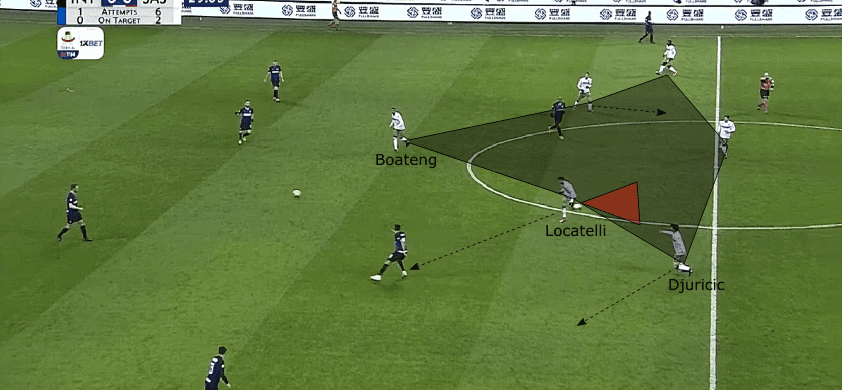
Locatelli and Duncan could either hold their position or pressure the centre-backs depending on the effort Boateng puts into pressing. Usually, Boateng would pressure one centre-back. When the ball travels to the other centre-back, the near-side attacking midfielder pushes out of the block and forces him further towards the sideline.
Consequently the whole team moves to that side while the attacking midfielder presses. The winger closes the passing lanes into the centre, but is always aware of the potential pass to Inter’s full-back whom he then pressures immediately.
Sensi, the central defensive midfielder, covers for the winger and marks Inter’s central midfielder in the half-space. To be horizontally compact enough, the far-side attacking midfielder drops into the midfield line and helps to cover the centre. Along with their close distances between the lines, they effectively shut down Inter and force them to the wings. As a consequence, Sassuolo can create an overload on the near side and defend Inter properly.
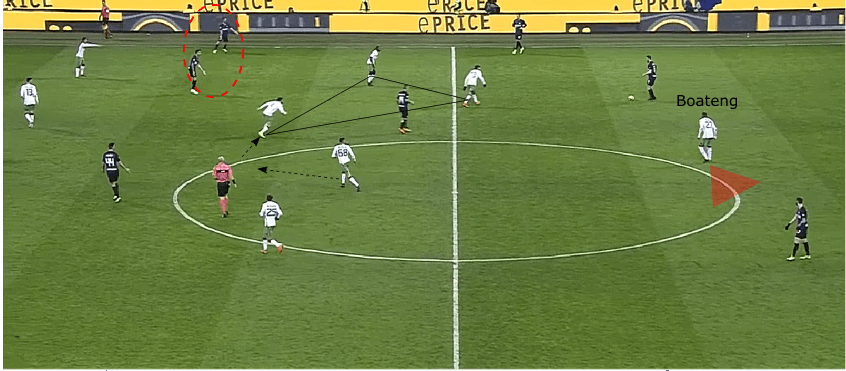
Again, you can see how Sassuolo close every passing lane by being diagonally positioned. Although Inter occupied the space between defence and midfield, they rarely played in that area because Sassuolo were so compact in the centre. However, Inter could have been more successful if their positioning had been better.
Higher right-back as a solution
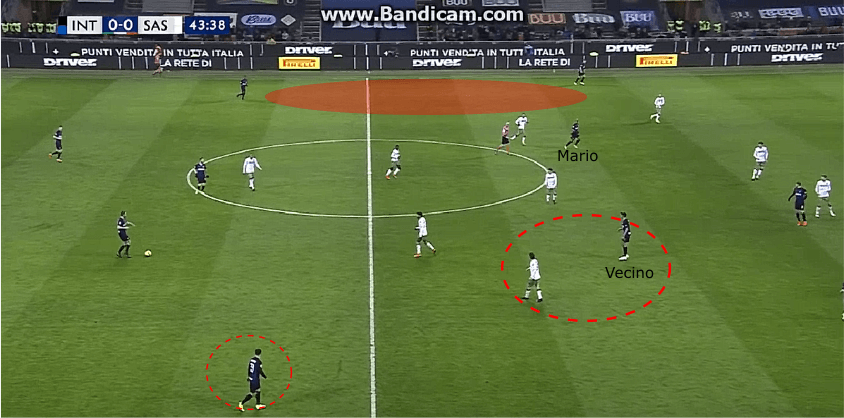
The formation of Sassuolo clearly had one disadvantage. They couldn’t cover the wings properly. Their approach was a little bit risky because they gave Inter an option to advance down the wings. Above all, the fact that only Sensi occupied the centre was an advantage for Inter which they didn’t exploit. Most of the time Inter just ineffectively switched to the other side, but their structure wasn’t good enough to penetrate the defensive block of De Zerbi’s team.
D’Ambrosio often stayed deeper which allowed Djuricic to focus more on the centre and cover the passing lane to Vecino. If the right-back pushes higher, the centre-back can advance with the ball and draw the attacking midfielder out of position. Then, Djuricic has to decide which passing lane he should cover. Inter could have got behind the midfield line of Sassuolo by simply pushing their right-back higher.
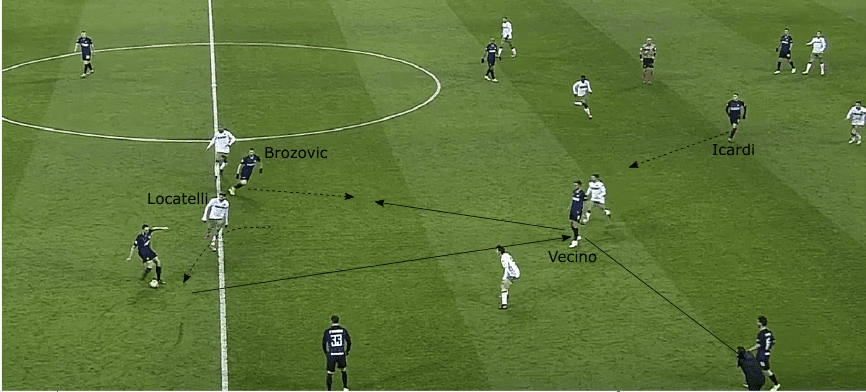
This was one of the rare examples in which Inter’s structure was good enough to use the holes in Sassuolo’s pressing. Locatelli moves out of position to press De Vrij. Djuricic can’t cover the passing lane to Vecino because Politano is staying wide. Additionally, Boateng is late in following Brozovic.
As a consequence, by passing the ball to Vecino, Inter had the possibility to get behind Sassuolo’s first line or even behind the second line by passing the ball to the wing. Icardi moved deeper occasionally. This could have been an interesting option but Inter rarely opened passing lanes to the Argentinian striker and the centre-backs preferred the wing.
The Brozovic problem
The role of Kevin-Prince Boateng was relatively simple. In the first half, Boateng stayed higher and covered the passing line between both centre-backs. The problem was that Boateng didn’t move deeper when Inter advanced. As a consequence, Brozovic got a lot of space.
Sassuolo quickly fell deeper and sometimes found themselves in a 4-5-1 without having access to the space around Brozovic. Inter did a good job in forcing Sassulo to position deeper in order to control every attacking player of Spaletti’s team.
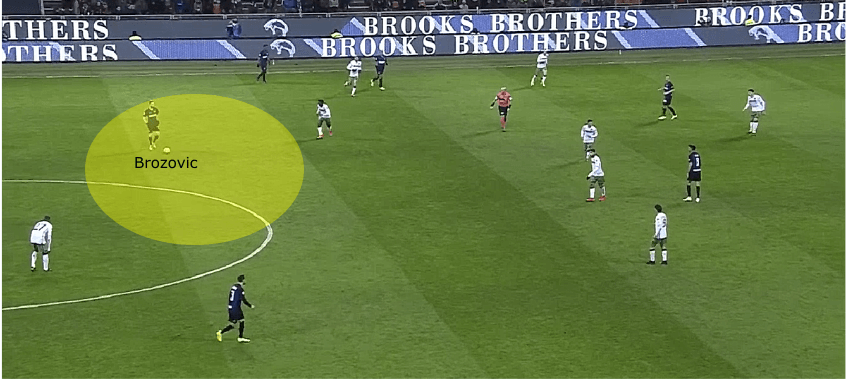
Quite often they circulated the ball from the wing-back to the centre. Sassuolo needed too much time to push out of position while Boateng stayed higher. The Croatian midfielder had a lot of space to distribute the ball. He controlled the game, dictated the rhythm and was responsible for the few creative passes in Inter’s attack.
The solution to the Brozovic problem
During halftime, De Zerbi adjusted the pressing of his team. Sassuolo pressed no higher and covered the passing lanes to Brozovic. Boateng now not only covered passes between the centre-backs but also those to the Croatian midfielder when the ball was on the wing.
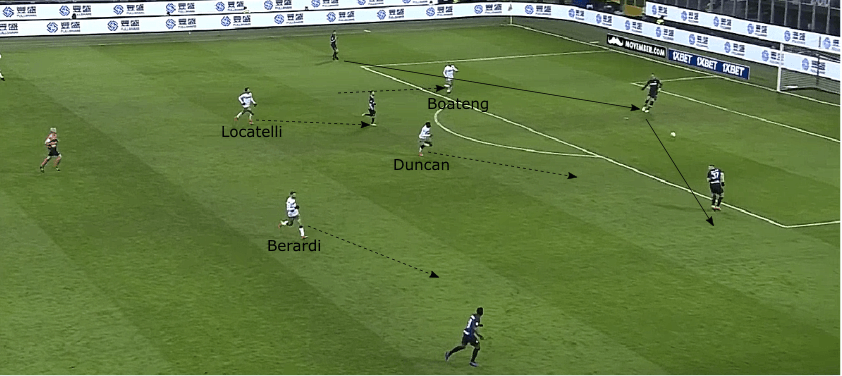
The above image shows was a decent example of the high pressing of Sassuolo. Boateng initiates the press by forcing Inter to switch. The former Frankfurt striker presses one of the centre-backs. Inter switch to the other side, and as a result the attacking midfielder (Duncan) pushes out of position to press. The other attacking midfielder (Locatelli) covers Brozovic to deny passes into the centre. The winger closes the half-space and is then able to press the full-back when he receives the ball.
Inter’s attacking game: a lack of connections
In the end, the game ended a goalless draw. While Sassuolo are probably happy with one point away against a side third in the league table, Inter had hoped for more. However, their attacking game was slow, without creativity and created no chances.
They rarely got their best players in qualitative, positional or numerical superiorities. All in all, they weren’t able to play passes between the lines and were often isolated on the wings.
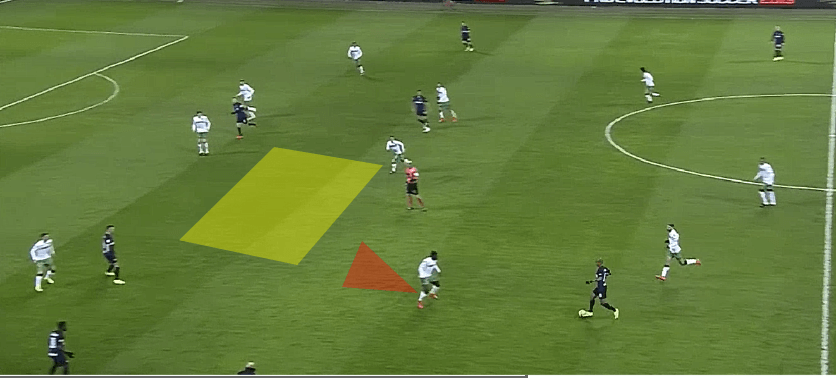
This example perfectly shows the problems of Inter. Although they have a triangle on the wing, their positioning was often weak. It was rare to see passes to the wingers when they were positioned in the half-space, nor could they really create chances from crosses. Joao Mário only has the wide full-back as a passing option. Furthermore, after a pass to the wing, Sassuolo can easily isolate them on the side.
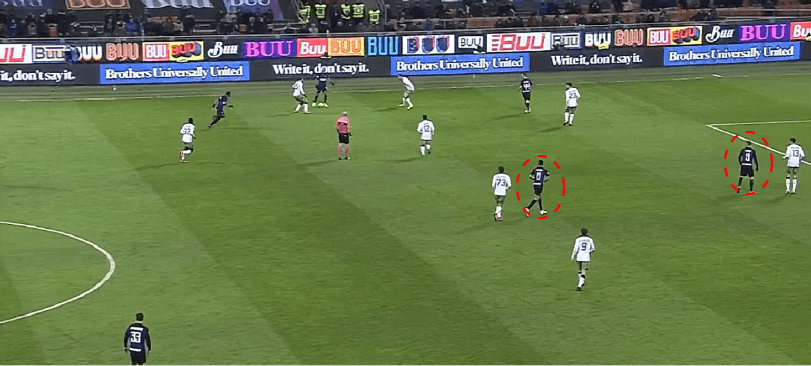
Although Mário and Vecino regularly occupied the space between the lines, either Inter couldn’t find them or they didn’t adjust their position properly when the ball was on the wing. That was a typical attack of Inter. As you can see, Sassuolo could create a 5v3 overload without fear of any other Inter attacking players being free.
Sassuolo’s build-up against Inter pressing
The game was quite chaotic, with a lot of turnovers and fights for second balls, especially in the second half. Sassuolo tried to be dangerous in transitions and consequently, we rarely observed a proper build-up from De Zerbi’s side. Against the pressing of Inter, they struggled to create enough connections in order to play through the opposition’s press.
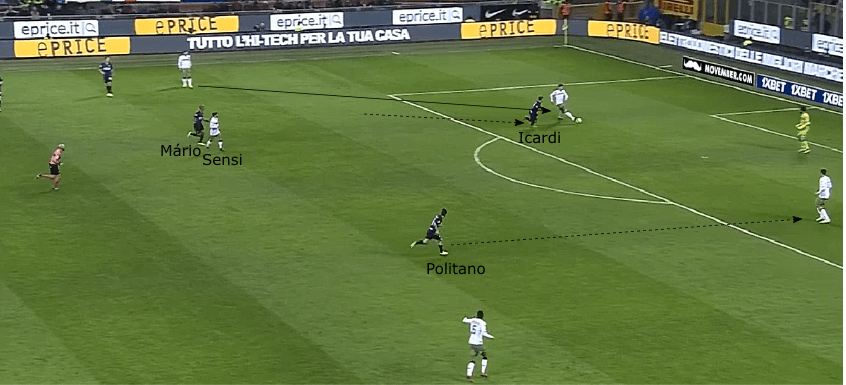
Inter usually pressed in a 4-2-3-1. Former West Ham loanee Joao Mário was responsible for covering Sensi, the focal point of Sassuolo’s build-up. Due to the relatively high attacking midfielders, Sassuolo’s centre-backs often faced situations in which they didn’t have a passing option in the centre. Long balls or turnovers in the centre were the result.
Inter used their wingers to press the far-side centre-back when he received the ball. Occasionally, Sassuolo played through the press. Either Sensi had a brilliant moment, Locatelli supported in deeper zones, or they found space behind Inter’s wingers.
Sassuolo dangerous attacks
If you look at the raw stats, Inter were the more dominant side and had the better chances. However, in some situations, Sassuolo were capable of creating dangerous opportunities in a low chance game. Compared to Inter, their structure was better and they created more passing options for the ball carrier.
Although it was far from a good performance from Sassuolo in possession – they lost a lot of balls early in the build-up – they still managed to draw their opponents into the centre of the pitch. Then, they quickly switched play to the open wide areas. In that way they created Boateng’s opportunity, which was by far the most dangerous in the game.
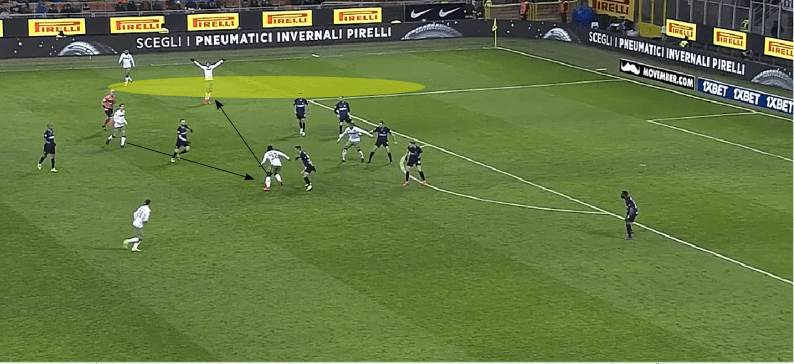
Conclusion
In the end, a draw was fair. Both teams pressed well but weren’t able to overplay their opponent’s pressing. Spaletti clearly has to improve the positioning of his team in possession. If not, they will struggle against a lot of smaller teams which are well-organized.
Sassuolo have to get back to their principles which made them so strong in the first half of the season. However, if the defence remains that insecure and disorganised, this is going to be hard.
If you love tactical analysis, then you’ll love the digital magazines from totalfootballanalysis.com – a guaranteed 100+ pages of pure tactical analysis covering topics from the Premier League, Serie A, La Liga, Bundesliga and many, many more. Buy your copy of the January issue for just ₤4.99 here, or even better sign up for a ₤50 annual membership (12 monthly issues plus the annual review) right here.

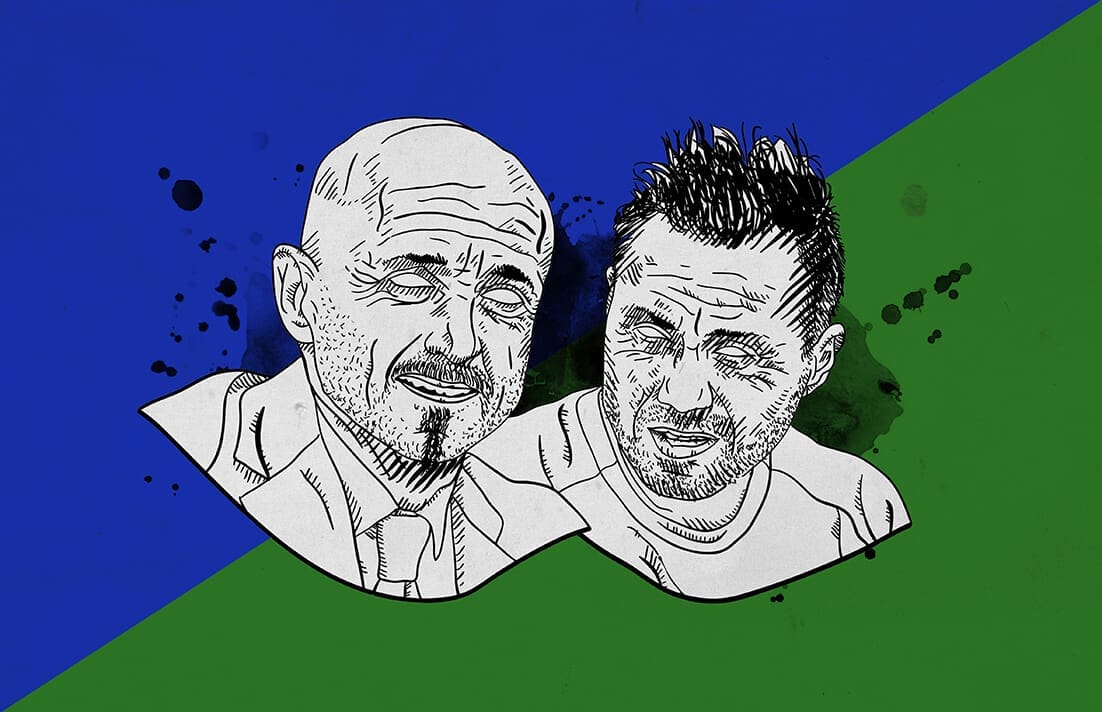



Comments